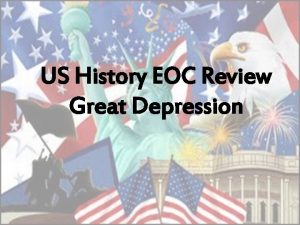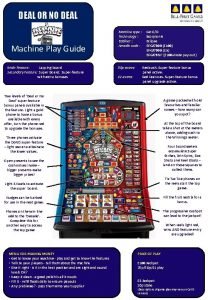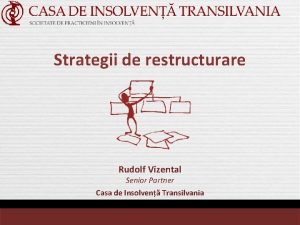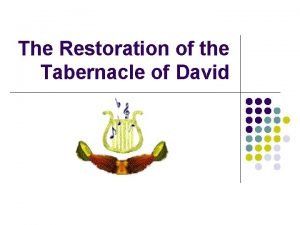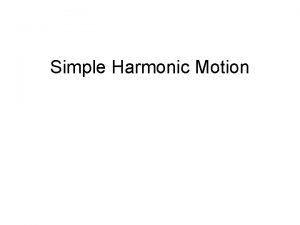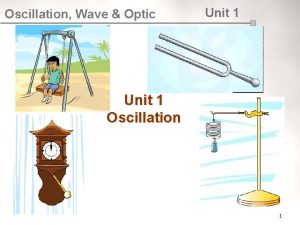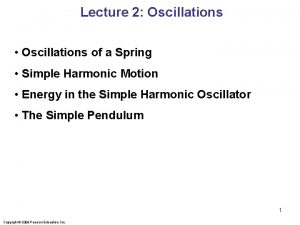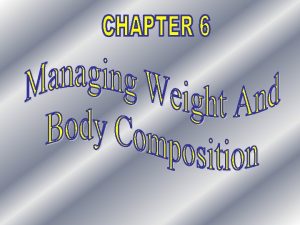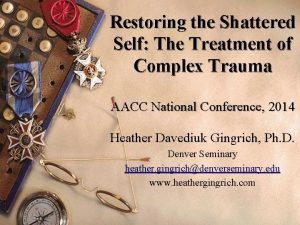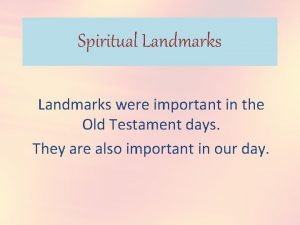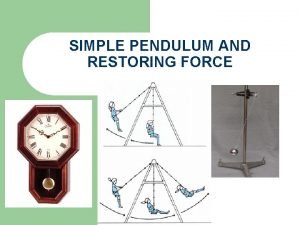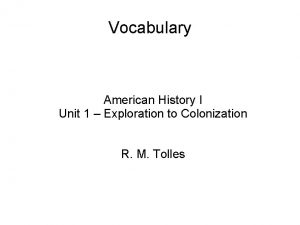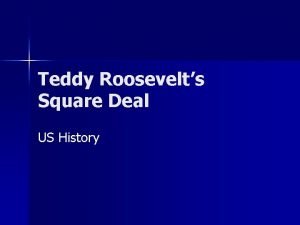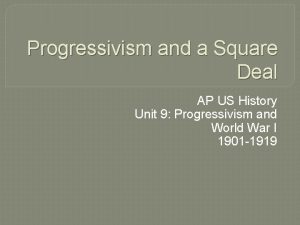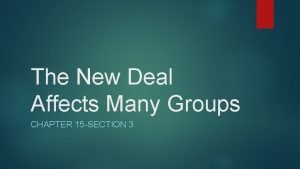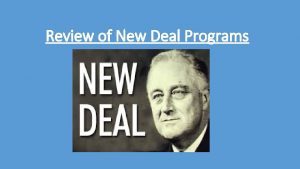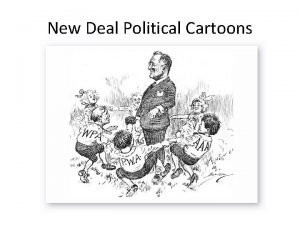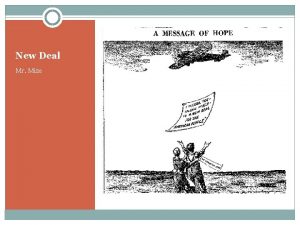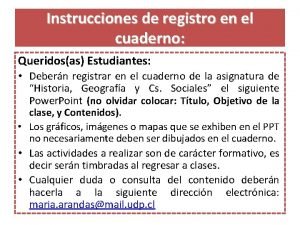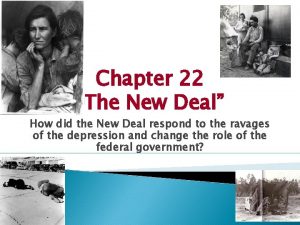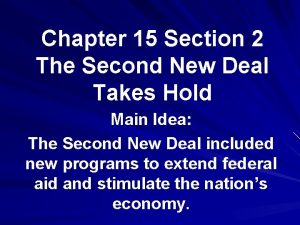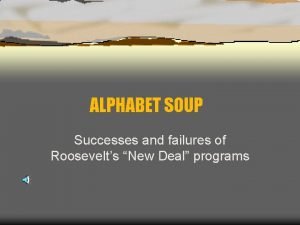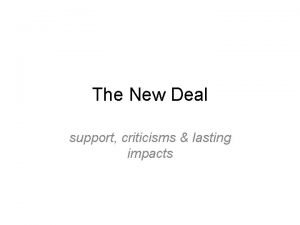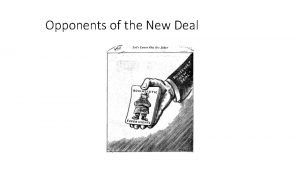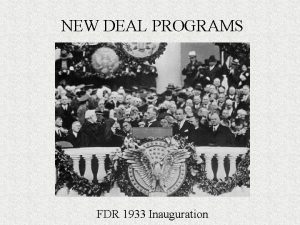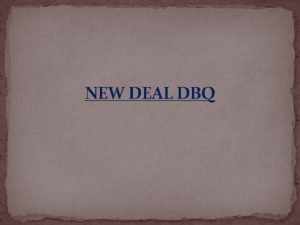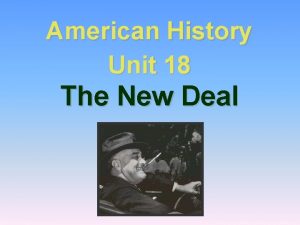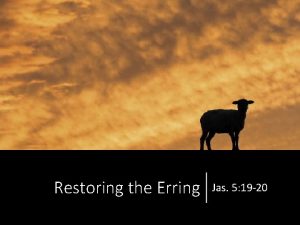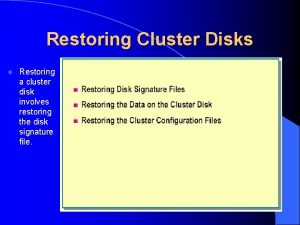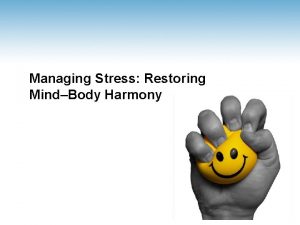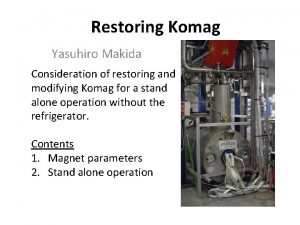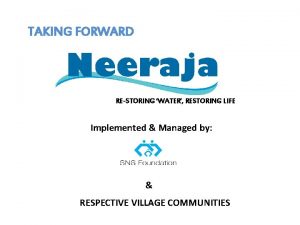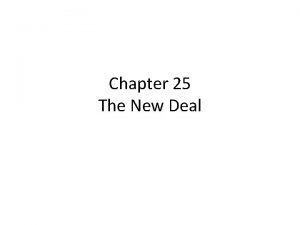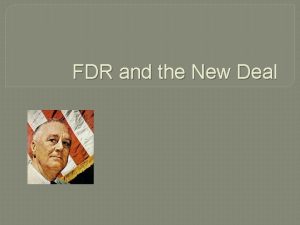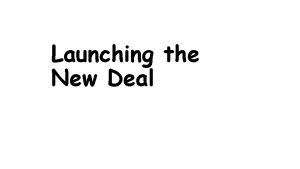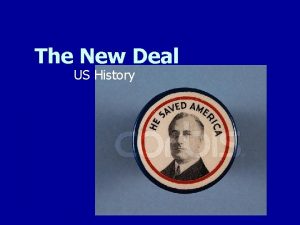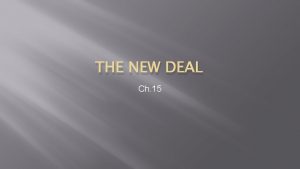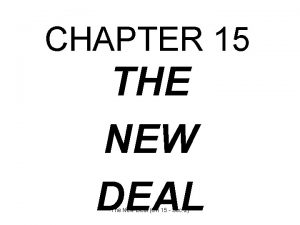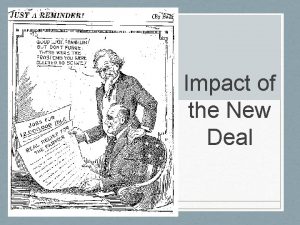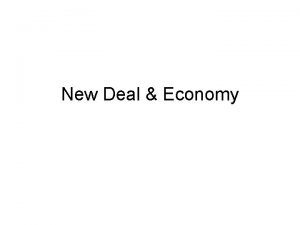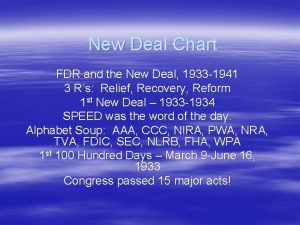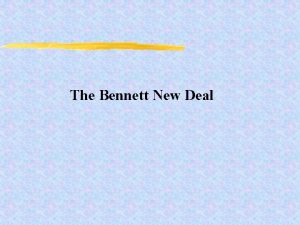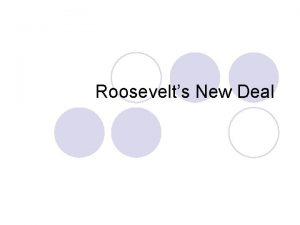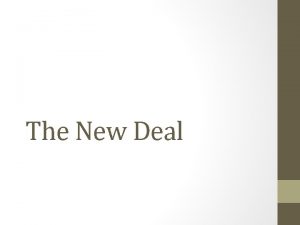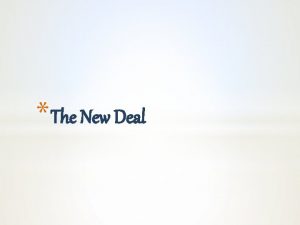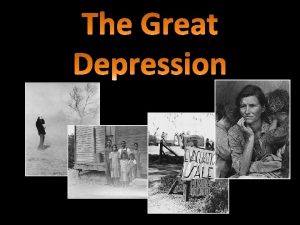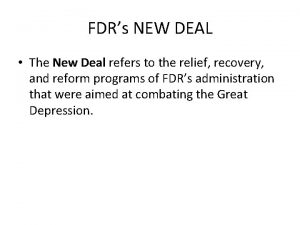American History Unit 18 The New Deal Restoring



































- Slides: 35

American History Unit 18 The New Deal

Restoring Hope and the First Hundred Days • ____________________________________ ________. • FDR promised “a new deal for the American people, ” but he wasn’t sure how to go about it. • The term New Deal came to represent the relief, recovery, and reform programs of FDR’s administration, aimed at eliminating the Great Depression.

Restoring Hope and the First Hundred Days • In the first hundred days of his presidency, Roosevelt pushed many programs through Congress to provide relief, create jobs, and stimulate the economy. • ____________________________________ ____________________________________.

Two, of Four, Areas of New Deal Reform Stabilizin FDR wanted to restore public confidence in the g Banks nation’s banks. Providing Relief and Creating Jobs ______________________________________________ ________. Congress also passed the Glass-Steagall Banking Act of 1933. This act established a Federal Deposit Insurance Corporation (FDIC) to insure bank deposits. ______________________________________________ _______________________. One public works program was the Civilian Conservation Corps (CCC). The CCC put more then

Two More Areas of New Deal Reform Regulati In 1933, Congress passed the National Industrial ng the Recovery Act (NIRA). NIRA established the National Economy Recovery Administration (NRA), which tried to balance the unstable economy through extensive planning. ________________________________________________ Assistin The ____________. Federal Housing Administration (FHA) worked to g Home- improve housing standards and conditions, and insure owners mortgages. and The Agricultural Adjustment Administration (AAA) raised Farmers farm prices through subsidies. They paid farmers not to raise certain crops and livestock, hoping that lower production would cause prices to rise. ________________________________________________

Key Players in the New Deal • FDR was the first President to appoint ______________________ __. • Frances Perkins, a former Progressive, became the Secretary of Labor. • She held the position until 1945. • ______________________

Key Players in the New Deal • Eleanor Roosevelt was one of FDR’s most important colleagues. • She threw herself into supporting the New Deal. • Occasionally the First Lady took stands that embarrassed her husband. • _______________________ ____________

The Second New Deal • When the New Deal failed to bring about significant economic improvement, critics began to attack the programs. • Opponents warned that New Deal agencies were giving increasing power to the federal government. • ____________________________________ __________________.

The Second New Deal • In response to the critics, FDR’s administration launched an even bolder set of legislation. • ______________________________________ ________. • New agencies attacked unemployment. • The Works Progress Administration (WPA) employed more than 8 million workers, building or improving playgrounds, schools, hospitals, and airfields.

New and Expanded Agencies • _____________________________________ ________. • The New Deal also brought electricity to rural America. • The Rural Electrification Administration (REA) offered loans to electric companies and farm cooperatives for building power plants and extending power lines.

New and Expanded Agencies • In July 1935, Congress passed the National Labor Relations Act, called the Wagner Act, which legalized such union practices as collective bargaining and closed shops. • Closed shops are workplaces open only to union members. • Congress also passed the Social Security Act. • _________________________________________ ______.

New and Expanded Agencies • The three types of insurance were: – ____________________________________ – Aid for dependent children, the blind, and the disabled

The 1936 Election • ___________________ ____. • FDR carried every state except Maine and Vermont, winning 523 -8 in the electoral college. • FDR’s victory showed

Limitations of the New Deal • The New Deal fell short of many people’s expectations. • ___________________________________ ______. • It set the minimum wage at 25 cents an hour, which was ____ what most workers already made. • The NRA codes, in some cases, permitted _____ for women’s work, and gave boys and men strong

Limitations of the New Deal ü No New Deal programs protected domestic service, the largest female occupation.

Limitations of the New Deal ü Many federal relief programs in the South reinforced ________ and because the Social Security Act excluded farmers and domestic workers, it failed to cover nearly two thirds of _______________.

Limitations of the New Deal ü FDR also refused to support a bill to make ______ a federal crime because he feared that _______________ ________

Political Critics New Deal Does Too Much • A number of Republicans, in Congress and elsewhere, opposed Roosevelt. • They believed that the New Deal went too far. • ______________________. • A group called the American Liberty League, founded in 1934, spearheaded much of the opposition. • ___________________________________________ ______.

Political Critics New Deal Does Not Do Enough • Many Progressives and Socialists attacked the New Deal because they believed that the programs did not provide enough help. • _________________________________ ________. • In 1934, Sinclair ran for governor of California on the Democratic ticket. • _________________________________ ________. • In Wisconsin, a Progressive candidate won the governorship.

Other Critics • ______________________________________________ _______. • One such demagogue was Father Charles E. Coughlin. • At times Father Coughlin contradicted himself. • ______________________________________________ _______. • Another time he defended the sanctity of private property. • At first he supported the New Deal, later he described Roosevelt as a “great betrayer and liar. ”

Other Critics • ____________________________________________ __________. • The goal was to limit individual personal wealth and increase the minimal income of all citizens. • Long also called for increased benefits for veterans, shorter working hours, payments for

Modern-Day Critics • Some historians and economists believe that the New Deal did not achieve the greatest good for the greatest number of Americans. • ____________________________________ ______. • They also charge that the programs created a bloated and powerful federal government and encouraged _______________.

Modern-Day Critics • Modern critics also attack the policy of __________________________. • In a time of hunger, the program wasted precious resources. • Farm production quotas penalized efficient and less-efficient farmers equally, while the free market would have weeded out inefficiency and rewarded productivity. • ________________________________________

Modern-Day Critics • Debate about the New Deal continues today. • Critics believe that the programs violated the free market system. • _______________________________.

The Court-Packing Fiasco • Roosevelt received criticism not only for his programs, but for his actions. • None aroused more suspicion than his attempt to “pack” the Supreme court. • ______________________________________________. • He recommended that Congress allow him to add six additional Supreme Court justices, one for every justice over 70 years old. • ______________________________________________. • _______________________

The Court-Packing Fiasco • Critics warned that FDR was trying to undermine the constitutional separation of powers. • ______________________________________________ _______. • In the end, FDR still wound up with a Court that tended to side with him. • ______________________________________________. • However, he also suffered political damage. • ______________________________________________

The Recession of 1937 • In August 1937, the economy collapsed again. • Industrial production and employment levels fell. • _______________________________________. • The new Social Security tax was partly to blame. • _______________________________________

The Recession of 1937 • ____________________________________ __________________. • The government borrows when its revenue, or income, does not keep up with its expenses. • ____________________________________.

Unions Triumph • In 1935, some union representatives wanted to create a place for unskilled labor within the American Federation of Labor. • __________________________________________ __________. • By 1938, the CIO coalition, or alliance of groups with similar goals, had 4 million members. • John L. Lewis became president of the CIO, which changed its name to the Congress of Industrial Organization. • _____________________

Unions Triumph • ________________________________________. • Many work stoppages took the form of sitdown strikes, in which laborers stop working, but refuse to leave the building and supporters set up picket lines outside. • ________________________________________ _______. • These tactics, although not always successful, proved quite powerful. • In 1939, the Supreme Court outlawed the sitdown strike as being too potent a weapon and

The New Deal’s Effects on Culture • Literature: Pearl Buck’s The Good Earth (1931), Zora Neale Hurston’s Their Eyes Were Watching God (1937), and John Steinbeck’s The Grapes of Wrath (1939) ________________________ ______. • ________________________ _____ masterpiece Let

The New Deal’s Effects on Culture • Radio and Movies: Radio became a major source of entertainment with comedy shows and the first soap operas. • ___________________________. • For a quarter, customers could see a double feature or take the whole family to a drive-in theater. • Some films of the day were Mr.

The New Deal’s Effects on Culture • The WPA and the Arts: FDR believed that the arts were not luxuries. • _________________ _________________ Istock. com image

Lasting New Deal Achievements • The New Deal had a profound effect on American life. • ____________________________________. • People accepted government intervention in their lives. • Workers demanded more changes in the ____________. • ____________________________________

Lasting New Deal Achievements • Many New Deal bridges, dams, tunnels, public buildings, and hospitals exist to this day. • ____________________________________ ______. • The Social Security system has gone through some changes, but is a part of the lives of all Americans. • Perhaps the New Deal’s greatest achievement was to
 What is the main idea of the cartoon?
What is the main idea of the cartoon? Deal or no deal machine
Deal or no deal machine Rudolf vizental
Rudolf vizental Great depression and new deal vocabulary
Great depression and new deal vocabulary Restoration of the tabernacle of david
Restoration of the tabernacle of david Spring constant formula
Spring constant formula Ap physics 1 shm review
Ap physics 1 shm review Oscillation
Oscillation Mechanical energy oscillating spring
Mechanical energy oscillating spring Maintaining a healthy body composition and body image quiz
Maintaining a healthy body composition and body image quiz Dissociative disorder not otherwise specified
Dissociative disorder not otherwise specified Types of landmarks
Types of landmarks Periodic motion
Periodic motion Benjamin west contributed a great deal to american art: …
Benjamin west contributed a great deal to american art: … American history unit 1 vocabulary
American history unit 1 vocabulary The greatest real estate deal in history
The greatest real estate deal in history Roosevelts square deal
Roosevelts square deal Square deal definition us history
Square deal definition us history The new deal an alphabet soup of agencies
The new deal an alphabet soup of agencies Chapter 15 section 3 the new deal affects many groups
Chapter 15 section 3 the new deal affects many groups John steinbeck apush
John steinbeck apush Aaa new deal
Aaa new deal Political cartoons fdr
Political cartoons fdr The new deal rrr
The new deal rrr Impacto de la gran depresion en chile
Impacto de la gran depresion en chile Emergency banking relief act (ebra)
Emergency banking relief act (ebra) The ingenious quarterback analysis
The ingenious quarterback analysis The second new deal takes hold chapter 15 section 2
The second new deal takes hold chapter 15 section 2 New deal alphabet soup
New deal alphabet soup New deal criticisms
New deal criticisms New deal
New deal Dust bowl migration map
Dust bowl migration map Charles coughlin criticism of the new deal
Charles coughlin criticism of the new deal The new deal webquest
The new deal webquest New deal programs
New deal programs William lloyd garrison jr new deal
William lloyd garrison jr new deal
